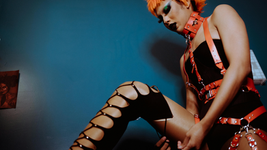'The Cult of Beauty' Review: Wellcome Collection Exposes the World's Largest Cult
- Stefi Komala
- Nov 4, 2023
- 4 min read
Updated: Nov 10, 2023
★★★★
What does it mean to be beautiful?
“The Cult of Beauty” exhibition explores this question through various sociocultural and geographic contexts. The artworks on display are made by a diverse group of creatives, and the historical artefacts come from many corners of the world. Despite this, the exhibition does not provide a chronology of our relationship with beauty. Instead, it highlights the aspects of this relationship which invoke the most thought-provoking questions; so by the time you’re out the door, you’re left with more questions than answers.

This seems intentional. The exhibition is full of insightful, descriptive panels that simultaneously pose rhetorical questions:
“Can our relationship with self-perception be an inspiring one?”
“With greater access to products and procedures both online and offline, how do we exercise our agency while prioritising our safety and wellbeing?”
“Is our understanding of beauty today truly becoming more inclusive?”
As I walk through the exhibition space, I am encouraged to reflect on hegemonic constructions of beauty, as well as my own complicity in upholding the cult of beauty. From the moment I entered the room, I was invited to engage in the discourse surrounding beauty.
Janice Li’s curation facilitates this discursive engagement in multiple ways. Firstly, it sheds light on the external factors which have influenced the definition of beauty. Secondly, it illustrates how beauty affects other aspects of our social identities, such as race, gender, age, and status.
The first section of the exhibition is filled with historical artefacts. These artefacts introduce the audience to traditional notions of beauty, and the exhibition’s commentary posits that these notions continue to shape cultural attitudes in the contemporary world. For instance, many artworks depicted the pursuit for eternal youth. Alchemists worked tirelessly to create elixirs of life, and nobles believed that drinking gold had anti-aging effects. Overall, there was no doubt that beauty was associated with youthfulness. This remains true today: many skincare products are marketed as anti-aging treatments, and others are specifically made to decrease the appearance of smile lines and wrinkles.
Once you make it through this section, you get to choose what comes next. There is no clear route, and you’re often forced to make a choice between going left or going right. I like to think that this is a part of the reflection process–I get to see which parts of the exhibition I am drawn too, and what that says about my personal relationship with beauty.
Fortunately, your chosen path isn’t a binding choice. You can walk back and browse through any sections that you’ve missed. Whichever way you go, there’s a lot to see and learn. Books from colonial times demonstrate how conceptions of beauty are entangled with problematic histories of racial fetishization and ethnographic profiling; Fenty Beauty's revolutionary foundation range is put on display, highlighting the need for everyday products that are inclusive and a card with Kate Moss’ lipstick kiss, which was sold for a whopping 60,000 pounds, shows the extent to which beauty has been commodified.
The most visually stunning works appear towards the end of the exhibition.
(Almost) all of my dead mother’s beautiful things, a sculpture by Narcissister, will definitely grab your attention. The sculpture is made up of memorabilia belonging to the artist’s late mother. The massive cluster of memorabilia is visually overwhelming, and Narcissister uses it to illustrate the “crushing weight of beauty ideals that are passed from one generation to the next.” Despite this, she does not reveal much about the memorabilia on display. All we know is that the sum of these parts tells the story of her mother’s life. Meaningful details can be observed from every angle, and I encourage future visitors to take their time when looking at this piece.

The artwork that captivated me most was Baum and Leahy’s Beauty Sensorium. It looked like a contraption from a mad scientist’s lab, or a magical device from a fantasy land. This multi-sensory installation was inspired by the “Renaissance Goo” Project. By drawing on the project’s findings, Baum & Leahy were able to recreate five “goos” (cosmetic recipes from the European Renaissance). The goos are displayed in mesmerising glass vessels that illuminate the room. But the installation doesn’t just look good—it smells good, too. Visitors are encouraged to smell the sweet, floral aromas and earthy scents emerging from the glass vessels. I loved this interactive element, especially since it felt like a relaxing break from the torrent of rhetorical questions.

Though many aspects of the exhibition are impressive, there are two things I would’ve changed.
Firstly, I would have loved a layout with more structure. There was no main path to follow throughout the exhibition; I was wandering back and forth, questioning whether I had accidentally walked past something important. On top of that, it was clear that certain sections of the exhibition were more closely related than other sections. The exhibition’s lack of structure made it more difficult to establish these connections. This can disrupt a visitor’s train of thought and compromise the quality of their reflections.
Secondly, some of the descriptive panels could use more accessible language. One of them states that “[the myth of perfect beauty] reinforces capitalist, consumerist, misogynistic socioeconomic systems and power structures.” The full implications of this statement may not be clear to everyone, especially if you haven’t studied these terms in an academic context.
Though the exhibition has its flaws, it’s still worth a visit. It covers a lot of ground, and it creates a fun space for self-reflection. Most importantly, it exposes the Cult of Beauty that so many of us have unknowingly worshipped.
“The Cult of Beauty'' is an exhibition at the Wellcome Collection (26 October 2023 – 28 April 2024). It is free to visit and no booking is necessary. You can find more information here.
Edited by Faye Elder, London and Beyond Editor


































Comments